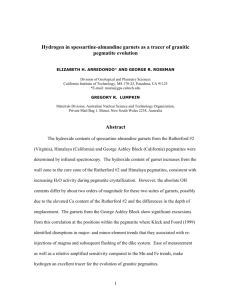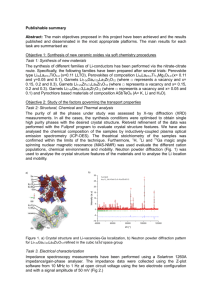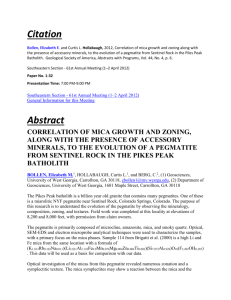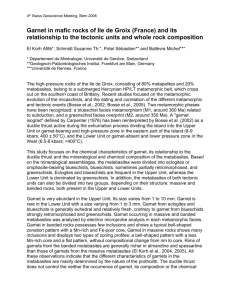OH Content - Mineral Spectroscopy - California Institute of Technology
advertisement
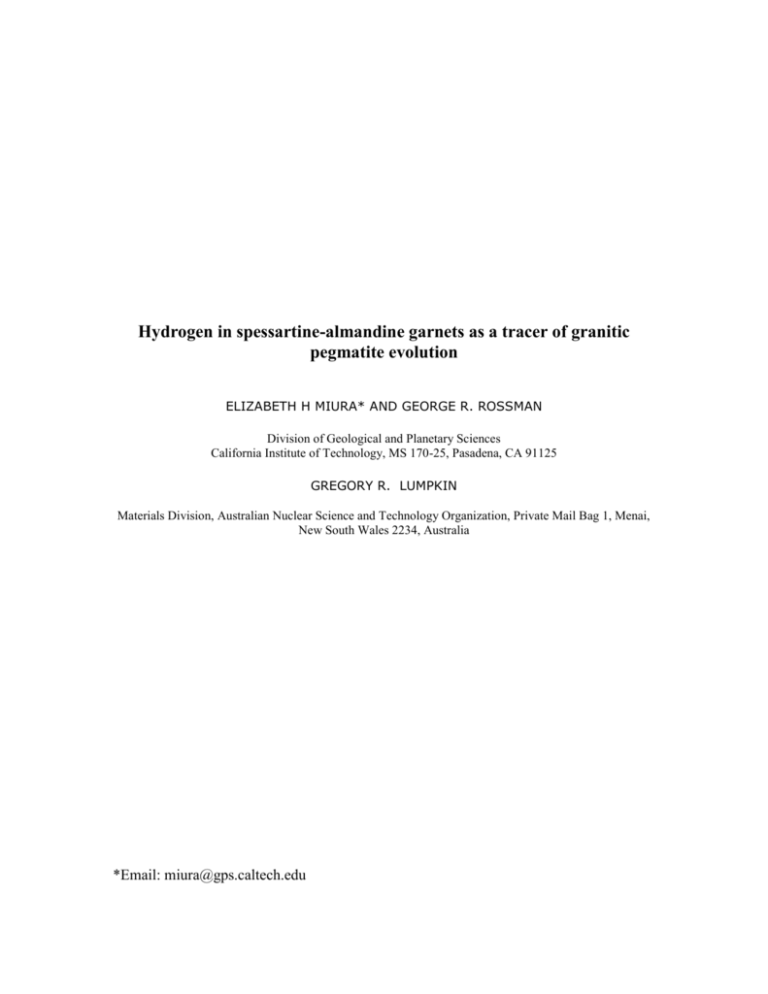
Hydrogen in spessartine-almandine garnets as a tracer of granitic pegmatite evolution ELIZABETH H MIURA* AND GEORGE R. ROSSMAN Division of Geological and Planetary Sciences California Institute of Technology, MS 170-25, Pasadena, CA 91125 GREGORY R. LUMPKIN Materials Division, Australian Nuclear Science and Technology Organization, Private Mail Bag 1, Menai, New South Wales 2234, Australia *Email: miura@gps.caltech.edu ABSRACT The hydrogen contents of spessartine-almandine garnets from the Rutherford #2 (Virginia), Himalaya (California) and George Ashley Block (California) pegmatites were determined by infrared spectroscopy. The hydrogen content increases from the wall to the core zone of the Rutherford #2 and Himalaya pegmatites but differ from each other by about two orders of magnitude for the garnets of about the same major element (Mn, Fe, Al, Si) composition. The garnets from the George Ashley Block show significant excursions from this correlation at the positions within the pegmatite where Kleck and Foord (1999) identified disruptions in major and minor elements trends that they associated with re-injections of magma and subsequent flushing of the dike system. Hydrogen has an amplified sensitivity compared to the Mn and Fe trends, thus making it a better tracer for the evolution of granitic pegmatites. INTRODUCTION Concentrations of Mn and Fe2+ in garnets correlate with the geochemical evolution of zoned pegmatite bodies (Baldwin and Knorring 1983; Whitworth 1992). Specifically, Mn contents progress from the wall zone to the core zone, as Fe2+ decreases. Hydrogen is also a component of pegmatitic garnets (Aines and Rossman 1984), but no known studies have looked at how H content correlates to the geochemical evolution of the pegmatite body. Rossman (1988) provide background and calibration information on OH in garnets, but does not provide specific correlation to pegmatite evolution. We have the opportunity to study Mn, Fe2+ and H in suites of spessartine-almandine garnets as 2 they evolve through three zoned North American pegmatites; the Rutherford #2 Pegmatite, George Ashley Block Pegmatite, and the Himalaya Dike System. The Rutherford #2 pegmatite is a steeply dipping, symmetrically zoned, lens shaped rare-element granitic pegmatite located near the town of Amelia in the Outer Piedmont province of central Virginia. Lumpkin (1998) provides the mineralogy and internal evolution information for this body. The George Ashley Block pegmatite (GAB) is a layered, asymmetric, pocket containing and peraluminous rockslide block located in the Pala pegmatite district of Southern California. Kleck and Foord (1999) report on its chemistry, mineralogy and petrology. The Himalaya Dike System, consists of a group of small relatively thin, continuous pegmatite dikes that are exposed along the east and northern flanks of Gem Hill. This dike system is located within the Cretaceous Mesa Grande pegmatite districts, within the Peninsular Ranges batholith in south central San Diego county. Foord (1976, 1977) extensively describes this system. EXPERIMENTAL METHODS SAMPLE DESCRIPTION A total of twenty-nine spessartine garnets were analyzed for this study (Table 1). Ten from the Rutherford #2 pegmatite, fifteen from the George Ashley Block (GAB) pegmatite and four from the Himalaya Dike system. The Rutherford and GAB garnets are from better-constrained areas in terms of pegmatite structure, while the Himalaya garnets are from relative areas (i.e. near wall zones or near pocket zones). Lumpkin (1998) subdivides the Rutherford #2 into five zones, each containing garnet. Wall zone samples (2) are euhedral crystals, red in color; vary in size from 2-10 3 mm, and are associated with oligoclase, microcline, muscovite, quartz, fergusonite and tourmaline. Second Intermediate Zone samples contain red-brown to red-orange 2-10 mm euhedral garnet crystals (4) with associated albite-oligoclase, muscovite, ferrocolumbite, fergusonite, microlite, and monazite associations. Middle Intermediate Zone samples contain red-orange to orange 5-15 mm subhedral crystals (2), with associated albite, muscovite, ferrocolumbite, microlite, and quartz. Inner Intermediate Zone samples contain orange to pale-orange 5-25 mm subhedral crystals (1), with albite, muscovite, manganotantalite, microlite, cassiterite, and fluorite. The Core Zone contains pale orange 5-15 mm subhedral crystals (1), with associated quartz, microcline, albite, muscovite, and apatite. The George Ashley Block garnet samples were collected across a fully exposed cross section of the pegmatite body by Kleck, as reported in Kleck and Foord (1999). Collection started at the lower contact of the wall (border zone), 0 cm, and continued approximately every 30 or 60 cm there after until the top was reached (810 cm). Garnets range in color from red to orange, and in size from 0.5 mm to 1.5 mm. The majority of the garnets are euhedral with well-developed crystal faces. Associated minerals through most of the traverse are quartz, potassium feldspar, Na-rich plagioclase, muscovite, and biotite, with replacement of biotite with tourmaline nearest to the core zone. The Himalaya Dike samples were not collected from a continuous traverse across the pegmatite body. Rather they were collected from dumps. Three whole rock samples were collected to represent various zones within the pegmatite, one showing a boundary contact with the host rock, one from near an intermediate zone, and one from near the pocket zone. Four garnet grains were extracted from these. The two garnet grains 4 extracted from the boundary rock are red in color and range in size from 1 mm to 5 mm. One garnet grain from the near intermediate zone is pale orange in color and was 2 mm in diameter. One garnet grain from the pocket zone area is pale orange in color 10 mm diameter. Associated minerals are quartz, Na-rich plagioclase, albite, muscovite, lepidolite (pocket zone), and tourmaline. OH DETERMINATION To determine the OH contents of the garnets, infrared spectral measurements were obtained on a Nicolet Magna 860 Fourier Transform Infrared Spectrometer operating at 4 cm-1 resolution. Each sample was doubly polished to an approximate 0.2 mm thick slab, and mounted over steel pinhole apertures (0.2- 0.4 mm diameters), which defined the region of interest. The OH content, expressed as weight % H was based on the spessartine calibration in Rossman et al. (1988), where in 0.1 weight % water corresponds to 2667 integrated absorbance per cm sample thickness in the 3750 to 3450 wavenumber (cm-1) range. The same calibration sample was reanalyzed after thinning to 0.183 mm because of the new instrument used in the current analyses. A new calibration was obtained where 0.1 weight % water = 2740 integrated absorbance per cm sample thickness. With just a 2.7% change in the sample calibration, we were unable to determine if this is a true revision of the calibration or just a manifestation of the heterogeneity within the sample. Throughout this paper the most recent calibration was used to determine H contents of all garnet samples analyzed. 5 ELECTRON MICROPROBE CHEMICAL ANALYSIS The Rutherford #2 pegmatite and the Himalaya Mine garnets were analyzed for major elemental compositions on Caltech’s Joel JXA-733 electron microprobe equipped with 5 wavelength-dispersive spectrometers, and a Tracor Northern energy-dispersive spectrometer operating at 15 KV accelerating potential and 25 nA probe current. Analyses are acquired using the Probe for Windows operating system, interfaced to the Tracor 5600 microprobe automation. For instrument calibration, well characterized conventional standards are used; details are available upon request. The GAB pegmatite garnets analyses are taken from Kleck & Foord (1999). RESULTS COMPOSITIONAL RESULTS Elemental analyses obtained at Caltech are reported in Table 1. Foord (1977) reported the chemical analysis of Himalaya Mine almandine-spessartine garnets in the wall zone to intermediate zones. They range in composition from Alm78Sps24Py3 to Alm49Sps50Py1, and within the pocket (core) zone, Alm0.5Sps99.5Py0. Data collected at Caltech, are in general agreement with the more extensive chemical study of garnets in the Himalaya Mine by Foord (1977). Furthermore, analyses of the Rutherford # 2 pegmatite garnets are generally similar to the Himalaya dike garnets in their respective zones. Plots of elemental composition as a function of elevation into the pegmatite body (wall to core (pocket) zone) for the Rutherford and Himalaya systems, display patterns of 6 increasing Mn and decreasing Fe2+ towards the pegmatite core (Figure 1, 2). The GAB on the other hand, displays a more complex pattern (Figure 3). Rather than monotonically increasing, the GAB undergoes several reversals and oscillations to near original compositional levels at approximately 150, 550 and 700 cm into the pegmatite. OH CONTENT The infrared spectra of the garnets yield OH absorption bands that are similar in shape and number to published spectra of OH in spessartine garnets (Aines and Rossman 1984), with prominent bands at 3580 cm-1, 3634 cm-1, 3624 cm-1 (Figures 4,5,6). H contents are presented in Table 1 and plotted against sample position for all three pegmatites. The Rutherford and Himalaya plots reveal that the H content increases from wall to core zones (Figures 7,8). The GAB displays a complex trend, where increases in H content are followed by sudden decreases at 150 cm and 550 cm and 700 cm (Figure 9). DISCUSSION This study was conducted to determine if the amount of H is correlated with the geochemical evolution of three zoned pegmatites. Results clearly show there is a general trend of increasing H content towards the core of the pegmatites. This is consistent with R.H. Jahns (1982) model of pegmatite genesis that predicts H and other incompatible elements increase towards the core of pegmatites as primary silicate minerals crystallize. In the case of the GAB, previous studies show a multi event growth history; the H pattern shows this same complexity. 7 Mn and Fe also track the evolution of the pegmatite from wall to core, a comparison of figures 3,4,5, to 7,8,9, shows that the H has proportionally a much greater change than the Mn or Fe content. In garnets from simple pegmatite systems, the wall to mid zone trends are that of generally rising H contents that generally mimic a corresponding trend of Mn contents. In the case of the GAB, the variation in H content vs. sample position are much more complex. Initially there is an increase as the garnets are extracted further from the wall, punctuated by an abrupt decrease in content at 150 cm followed by a rise then fall at 550 cm, another rise then a fall at 700 cm, then a final rise to 810 cm. In the 150 to 550 cm range, there is a suggestion of a symmetrical H content centered at about 350 cm. This is the same range where Kleck and Foord (1999) suggested resetting occurred in the magma. We note that H is a particularly sensitive component due to its proportionally greater range of variation. It is particularly satisfying that the H content responds at the same positions at which Kleck and Foord (1999) interpreted the chemical compositions to reset by multiple stages of magma injections and subsequent flushings. Although these events were not observed visually (W. Kleck, personal communication) their presence in trace element signatures, particularly H is obvious. Because of the widespread occurrence of garnets in many pegmatites, the study of H may have wide applications as a tracer for the evolution of pegmatites. The absolute concentration of H in the three pegmatites varies by two orders of magnitude; a question remains whether these differences are related to differences in the absolute H content in the magma at total pressure and depth of emplacement, or to other chemical variations in the garnet. We note that garnets in all three pegmatites have 8 relatively the same Mn/Fe ratio, so the differences cannot be due to that ratio alone. We also looked at minor and trace elements, to see if they correlated with H. These studies have not identified any viable minor or trace component with which hydrogen is clearly associated. The success of the sensitivity of hydrogen as a tracer and its correlation with the evolution of simple pegmatites also raises the possibility that other anhydrous phases, quartz and feldspar, might show these same correlations. ACKNOWLEDGEMENTS This work was funded in part by National Science Foundation (USA) grant EAR9804871. Thanks to Wallace Kleck for providing well documented GAB samples and helpful discussions. Thanks to William F. Larson for access to the Himalaya Mine for sample collection. Others to come for reviews… REFERENCES CITED Aines, R.D., and Rossman, G.R. (1984) The hydrous component in garnets: Pyralspites. American Mineralogist, 21, 1116-1126. Baldwin, J.R., and Knorring, O.V. (1983) Compositional range of Mn-garnet in zoned granitic pegmatites. The Canadian Mineralogist, 21, 683-688. Foord, E.E. (1976) Mineralogy and petrogenisis of layered pegmatite-aplite dikes in the Mesa Grande District, San Diego County, California, 326 p. Ph.D. dissertation, Stanford University, California. ——(1977) The Himalaya dike system. The Mineralogical Record, 8, 461-474. 9 Jahns, R.H. (1982) Internal evolution of pegmatite bodies. Mineralogical Association of Canada: MAC Short Course Handbook, 8, 293-327. Kleck, W.D., and Foord, E.E. (1999) The chemistry, mineralogy, and petrology of the George Ashley Block pegmatite body. American Mineralogist, 84, 695-707. Lumpkin, G.R. (1998) Rare-element mineralogy and internal evolution of the Rutherford #2 pegmatite, Amelia County, Virginia: A classic locality revisited. The Canadian Mineralogist, 36, 339-353. Rossman, G.R., Rausch, F., Levi, R., Trombello, T.A., Shi, C.R., and Zhon, Z.Y. (1988) Nuclear reaction analysis of hydrogen in almandine, pyrope, and spessartine garnets. Neues Jahrbuch für Mineralogie Monatshefte, 172-178. Whitworth, M.P. (1992) Petrogenetic implications of garnets associated with lithium pegmatites from SE Ireland. Mineralogical Magazine, 56, 75-83. Table 1. Elemental Compositional analyses on the a) Rutherford #2, b) Himalaya, and c) George Ashley Block pegmatite garnets. Figure 1. Rutherford #2 garnet wt% Mn, Fe vs. sample position. 10 Figure 2. Himalaya Dike garnet wt% Mn, Fe vs. sample position. Figure 3. George Ashley Block (GAB) wt% Mn, Fe vs. sample position. Figure 4. Rutherford #2 garnet OH absorbance. Figure 5. Himalaya dike garnet OH absorbance. Figure 6a. GAB garnet OH absorbance 0-120cm. Figure 6b. GAB garnet OH absorbance 150-540cm. Figure 6c. GAB garnet OH absorbance 540-810cm. Figure 7. Rutherford #2 garnet wt% H vs. sample position. Figure 8. Himalaya dike garnet wt% H vs. sample position. Figure 9. GAB wt% H vs. sample position. 11
